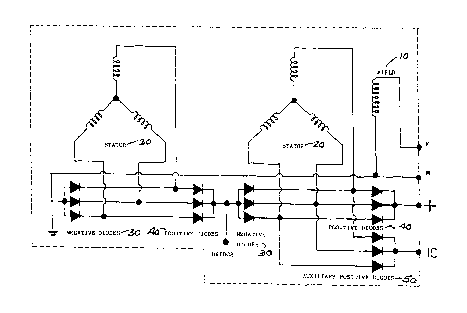Some of the information on this Web page has been provided by external sources. The Government of Canada is not responsible for the accuracy, reliability or currency of the information supplied by external sources. Users wishing to rely upon this information should consult directly with the source of the information. Content provided by external sources is not subject to official languages, privacy and accessibility requirements.
Any discrepancies in the text and image of the Claims and Abstract are due to differing posting times. Text of the Claims and Abstract are posted:
| (12) Patent: | (11) CA 2240059 |
|---|---|
| (54) English Title: | INTELLIGENT CHARGE ALTERNATOR |
| (54) French Title: | ALTERNATEUR INTELLIGENT |
| Status: | Expired and beyond the Period of Reversal |
| (51) International Patent Classification (IPC): |
|
|---|---|
| (72) Inventors : |
|
| (73) Owners : |
|
| (71) Applicants : |
|
| (74) Agent: | GOWLING WLG (CANADA) LLP |
| (74) Associate agent: | |
| (45) Issued: | 2000-10-24 |
| (22) Filed Date: | 1998-06-09 |
| (41) Open to Public Inspection: | 1998-12-10 |
| Examination requested: | 1998-06-09 |
| Availability of licence: | Yes |
| Dedicated to the Public: | N/A |
| (25) Language of filing: | English |
| Patent Cooperation Treaty (PCT): | No |
|---|
| (30) Application Priority Data: | ||||||
|---|---|---|---|---|---|---|
|
An intelligent charge alternator is disclosed and is adapted to operate with
two or more batteries which are individually charged, alone or connected in
series. In each stator slot there are 2, 3, 4, etc., windings in parallel and each
coil is independent to the other. It requires a rectifier bridge for each coil in
parallel, either star, triangle, diphase, or single-phase winding and can be
connected in series. The batteries can also be connected individually or in series
between negative positive negative pole, etc., adding in this case the voltages, but
it will charge the discharged battery in amperes and it will not charge the charged
battery with over potential.
Alternateur intelligent pouvant fonctionner avec deux batteries ou plus, lesquelles sont chargées individuellement et raccordées individuellement ou en série à l'alternateur. Chaque encoche du stator loge au moins 2 bobinages en parallèle, chacun des enroulements étant autonome. Le dispositif nécessite un support de diodes pour chaque enroulement monté en parallèle, soit en étoile, en triangle, biphasé ou monophasé, et peut être raccordé en série. Les batteries peuvent également être raccordées individuellement ou en série, entre pôles négatif, positif, négatif, etc. Les tensions sont ainsi additionnées et chargent les batteries déchargées sans toutefois surcharger celles qui le sont déjà.
Note: Claims are shown in the official language in which they were submitted.
Note: Descriptions are shown in the official language in which they were submitted.

2024-08-01:As part of the Next Generation Patents (NGP) transition, the Canadian Patents Database (CPD) now contains a more detailed Event History, which replicates the Event Log of our new back-office solution.
Please note that "Inactive:" events refers to events no longer in use in our new back-office solution.
For a clearer understanding of the status of the application/patent presented on this page, the site Disclaimer , as well as the definitions for Patent , Event History , Maintenance Fee and Payment History should be consulted.
| Description | Date |
|---|---|
| Inactive: IPC from MCD | 2006-03-12 |
| Inactive: IPC from MCD | 2006-03-12 |
| Time Limit for Reversal Expired | 2003-06-09 |
| Letter Sent | 2002-06-10 |
| Publish Open to Licence Request | 2001-05-25 |
| Grant by Issuance | 2000-10-24 |
| Inactive: Cover page published | 2000-10-23 |
| Pre-grant | 2000-07-18 |
| Inactive: Final fee received | 2000-07-18 |
| Letter Sent | 2000-06-16 |
| Amendment After Allowance Requirements Determined Compliant | 2000-06-16 |
| Amendment After Allowance (AAA) Received | 2000-05-23 |
| Inactive: Amendment after Allowance Fee Processed | 2000-05-23 |
| Letter Sent | 2000-01-18 |
| Notice of Allowance is Issued | 2000-01-18 |
| Notice of Allowance is Issued | 2000-01-18 |
| Inactive: Approved for allowance (AFA) | 1999-12-10 |
| Application Published (Open to Public Inspection) | 1998-12-10 |
| Classification Modified | 1998-09-24 |
| Inactive: First IPC assigned | 1998-09-24 |
| Inactive: IPC assigned | 1998-09-24 |
| Filing Requirements Determined Compliant | 1998-08-19 |
| Inactive: Filing certificate - RFE (English) | 1998-08-19 |
| Application Received - Regular National | 1998-08-18 |
| Request for Examination Requirements Determined Compliant | 1998-06-09 |
| All Requirements for Examination Determined Compliant | 1998-06-09 |
There is no abandonment history.
The last payment was received on 2000-05-26
Note : If the full payment has not been received on or before the date indicated, a further fee may be required which may be one of the following
Please refer to the CIPO Patent Fees web page to see all current fee amounts.
| Fee Type | Anniversary Year | Due Date | Paid Date |
|---|---|---|---|
| Application fee - small | 1998-06-09 | ||
| Request for examination - small | 1998-06-09 | ||
| 2000-05-23 | |||
| MF (application, 2nd anniv.) - small | 02 | 2000-06-09 | 2000-05-26 |
| Final fee - small | 2000-07-18 | ||
| 2001-05-25 | |||
| MF (patent, 3rd anniv.) - small | 2001-06-11 | 2001-05-25 |
Note: Records showing the ownership history in alphabetical order.
| Current Owners on Record |
|---|
| OLINDO LUCA JULIO DURELLI |
| Past Owners on Record |
|---|
| None |